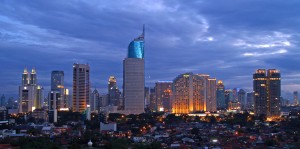 Jakarta Population 2013
Jakarta Population 2013
The most recent estimate for the population of the city of Jakarta, Indonesia is about 10,188,000, which is an increase of about 6.3% from the last record of the population. Not only is Jakarta the capital city of Indonesia, but it is also the largest city in the entire country. It is also the thirteenth largest city in the entire world, right behind Shenzen, China. Based on the total land area and the total population of the city, the population density of Jakarta is about 39,740 people per square mile.
Demographics of Jakarta
The original ethnicity of the inhabitants of Jakarta was those that identify as Betawi. Betawi developed in the beginning from a mixed ethnic culture of the Sudanese, Balinese, Malayan, Maluku, Chinese, and some others also inhabited the city. Malay with an influence of Portuguese was the main language spoken. Eventually, the main cultures began to assimilate into one culture, which became the Betawi culture. The Situ Babakan is the cultural preserve intended to preserve the culture of the Betawi people. The main language spoken in the city is Indonesian. However, in the workplace, English is commonly used. Also, some of the inhabitants of the city study and know Dutch, French, German, Mandarin, Arabic, and Japanese.
Religion in Jakarta
The main religion in not only the city of Jakarta, but also the country of Indonesia is Islam. However, there are many controversies surrounding religion in Jakarta right now. There is a growing sense of intolerance towards non-Islamic religions, especially towards the opening of new churches in the city. Those persecuted specifically include Christians and even the non-believers or atheists. However, not all of the Muslims in the city are radicals that participate in this behavior; many of the moderate Muslims condemns this religious intolerance and persecution.
Economy of Jakarta
The city of Jakarta is known as the economic center of Indonesia. The major industries of the city include electronics, automotive, chemical mechanical engineering, and the biomedical sector. There is also a lot of natural resource (e.g. oil, gas, coal, and gold) mining that takes place in the city. The Jakarta Central Business District is also a major component of the economy, made up of insurance and financial companies. An interesting fact is that private foreign insurance companies are not allowed to operate in Indonesia, which means not in Jakarta.
Sports in Jakarta
The city of Jakarta has three major sports teams: Persija, Persitara, and the Indonesian National Basketball team. Persija plays football in the Bung Karno Stadium, which is the biggest stadium in all of Jakarta, hosting about 88,000 fans. Persitara also plays football in Kamal Muara Stadium. Lastly, the Indonesian National Basketball team plays in the Kelapa Gading Sport Mall in North Jakarta.
The Greater Jakarta
Historical Population of Jakarta
The population of Jakarta has consistently increased every decade since the beginning of the 20th century. While some population growths from decade to decade were steeper than others, the total population count still increased over the course of those decades, except during the years 2006 and 2007.
| Year | Population |
| 1901 | 115,900 |
| 1905 | 138,600 |
| 1918 | 234,700 |
| 1920 | 253,800 |
| 1925 | 290,400 |
| 1928 | 311,000 |
| 1930 | 435,184 |
| 1940 | 533,000 |
| 1945 | 600,000 |
| 1950 | 1,733,600 |
| 1959 | 2,814,000 |
| 1961 | 2,906,533 |
| 1971 | 4,546,492 |
| 1980 | 6,503,449 |
| 1990 | 8,259,639 |
| 2000 | 8,384,853 |
| 2005 | 8,540,306 |
| 2006 | 7,512,323 |
| 2007 | 7,552,444 |
| 2010 | 9,588,198 |


